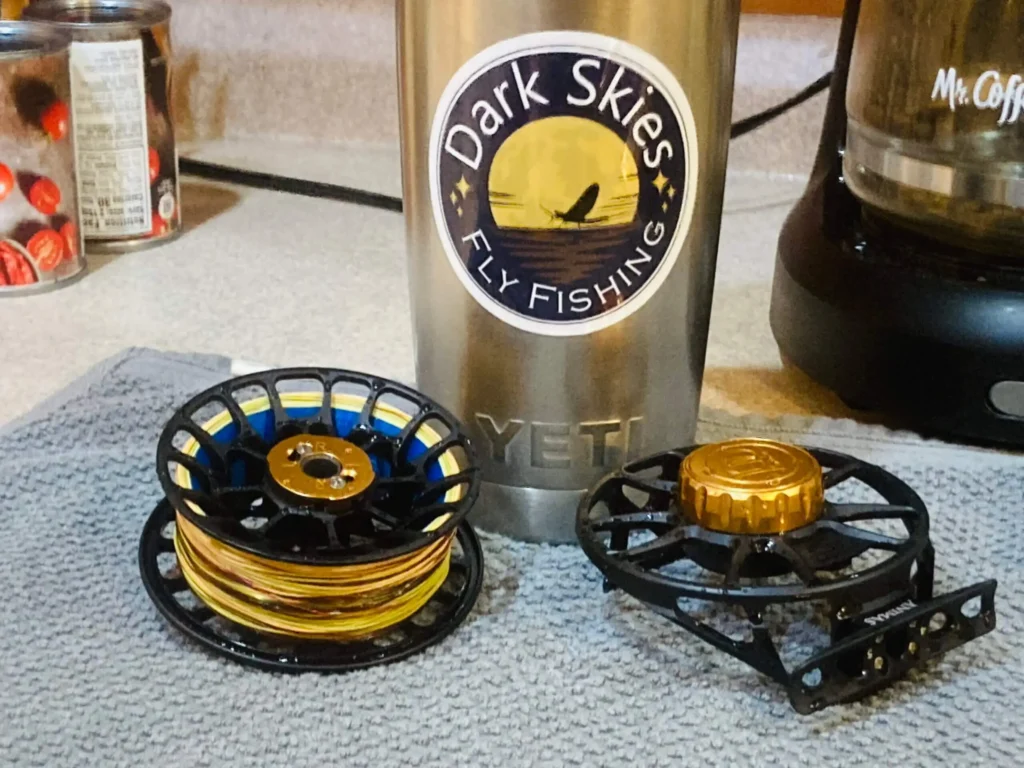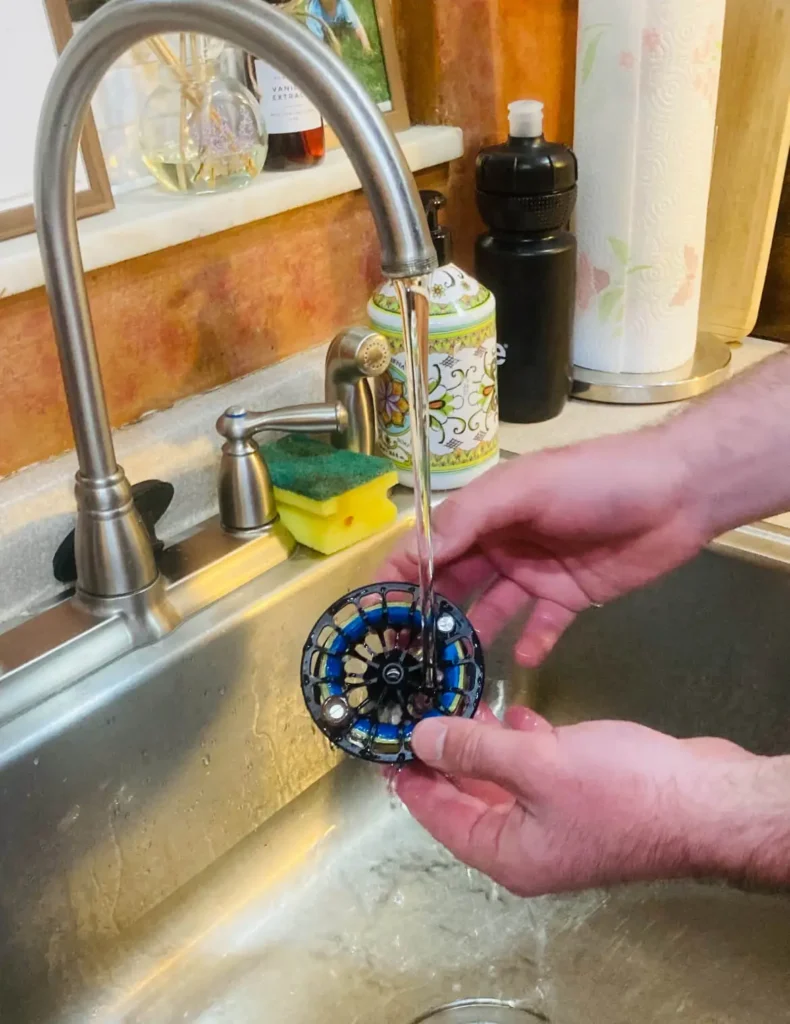Fly Reel Care and Maintenance

Although the maintenance on most contemporary fly reels is minimal, there are a few preventative measures that should be taken first during and then at the conclusion of each fishing session. If you are like me, your sentiment of a highly performing trout reel is one that does not require thought or attention. As a matter of fact, my fly reels serve two primary purposes, first as a means to hold my fly line and leader, and second, providing quality drag in the event I stick a big fish.
Other than liking my fly reels to look sexy with well-machined shapes, ports and parts, I don’t want to think about them at all on the water. Regularly following these simple preventative maintenance steps, a quality fly fishing reel can provide a lifetime and beyond of functional service requiring little to no thought.
The On-Stream Rinse
How many times has an angler placed the reel end of his or her rod in the sand on the stream bank to change flies? Or positioned the reel and cork grip lying in the gravel in the stream shallows to snap the perfect picture of a fish? Finally, tossing the fishing reel into the stream side weeds in order to safely unhook and release a fish? Personally, I have not only seen these behaviors, but I have participated in each of them, too. Every single fishing session!
Each time your reel is set down on the bank or on the bottom of shallow bank water, sand, silt, pebbles and wood debris are introduced and trapped in the line coils and in between the spool and reel frame. This abrasive debris trapped in the fishing reel creates wear on the moving parts and will inevitably result in irreversible damage.
Use the preventative on-stream rinse every time the fishing rod and reel is set down during a fishing session. The procedure is simple and takes seconds! I like to wade out in shin to knee-deep water in swift current and dunk my fly rod butt and reel a few inches below the surface. I first rinse one side using the stream current and then turn the rod and reel over and rinse the other side, pick up, shake off the water and resume fishing. Done and dusted!
If the day is very cold, this can cause freezing troubles. However, there is no work-around for this problem that I am aware of.

Reel Inspection
Following a fishing session, with the reel removed from the rod, complete a quick functional diagnostic. Begin by winding the reel with all of the line and leader on the spool. If there is a grinding sound or sensation, the reel feels sticky or stiff to turn or abruptly starts/stops, immediately STOP! These sensations are being caused by debris in between the reel frame and spool and the reel needs to be rinsed as soon as possible.
Next, inspect all parts for noticeable damage. Inevitable scratches and dings are going to happen. These are simply cosmetic and add character to the fishing reel, rarely impacting performance. However, if the reel is not spinning smoothly, ticks or hangs up while winding, there is a good chance that the spindle, spool, or frame is bent.
Never force-wind the reel as this will possibly result in increased damage. Likely the reel will need to be returned to the manufacturer for warranty or repair. And, if the reel is of high quality from a reputable company then this will surely be honored.

At-Home Reel Maintenance
Upon arriving home, wet and tired from fishing hard all day, perform the most crucial of the preventative maintenance steps: the at-home rinse. Remove the lined spool from the reel frame. Using cool, light pressure tap water, rinse the entire frame inside and out. If it is your preference, fill a container with cool, freshwater and swish it back and forth.
Use your finger to wipe away dirt, sand or debris from the porting and machined or cast edges on and in the frame. Next, gently shake and dry water from exposed surfaces with a clean, soft cloth and set the frame aside.
It is very important not to use oils, greases and other lubricants on reel parts. I also strongly warn against using soaps and detergents. Consult your owner’s manual concerning this. However, I have found that most quality fly fishing reels strictly forewarn against the use of oils and greases because drags and spindles and bearing surfaces are either sealed or use a solid Teflon lubricant. I have an affinity for Ross Reels and the manuals claim that using additional lubricants can damage parts and void warranties.
After rinsing the reel frame, move onto the lined spool. Again, rinse thoroughly using cool, low pressure freshwater. Take more time to rinse the exposed leader and line. There is no need to remove the line to rinse unless you really want to get after it. Nevertheless, this constitutes line maintenance — which you can read about on this website by clicking here.
Again, work your fingers into porting, edges and machined or stamped creases. Gently shake and towel dry inside and out.

Drying the Reel and Long-term Storage
Find a safe shelf, table top or work bench out of direct sunlight to set your reel aside to completely air-dry. Leave the spool detached from the frame and set out to dry resting on a soft cloth. My wife, a very understanding spouse, was not thrilled years ago when I set my fishing reel out to dry on a nice coffee table in which rinse water drained. The result was a water stain on the finished wood surface of the furniture!
Remember, backing material is absorbent and rinsing thoroughly soaks this component because of the open design of many contemporary fly reels. It requires a long time to completely dry.
I like to overdo this step and leave my reels set out to dry for upwards of 72 hours or more. Of course, this is not possible when fishing for consecutive days or multiple sessions during a week. This is not a problem, but when putting reels away for an extended period, simply make sure they are completely dry first. There is a good reason for the age old adage, “worked hard and put away wet” because this practice increases damage.
Once they’re completely dry, I store my reels in sleeves in a duffel or displayed on a shelf in a dark and dry basement room. I believe that harmful UV light can really damage the PVC surfaces of lines and finished reel surfaces due to prolonged exposure, so it is best to store lined reels in a dry and dark environment for extended periods.
Maintaining quality fly fishing reels really is a snap. Consequently, these finally crafted tools are designed to be nearly maintenance free! Following these basic and simple preventative maintenance steps will keep fishing reels in top working order and assure that they function flawlessly season after season. I hope, many years from now, my boys and/or future grandchildren will someday fish with my favorite fly reels, too, enjoying countless hours using them, but not thinking about them, when on the trout stream.
Looking to take your fishing to the next level?
Book a day on the water where we can show you how to read the water, make better presentations, catch more fish, and enjoy time spent outdoors more than ever before.
Book Now!Did You Find This Article Helpful?
Stay up to date with the Dark Skies Fly Fishing monthly newsletter for free and receive the latest posts in fly fishing news, tricks, tips, and techniques, stream reports, as well as updates on new flies added to the Online Store and exclusive discounts!
Sign Up Now
* “Love your writing style – informative and makes me want to grab my rod right now!”